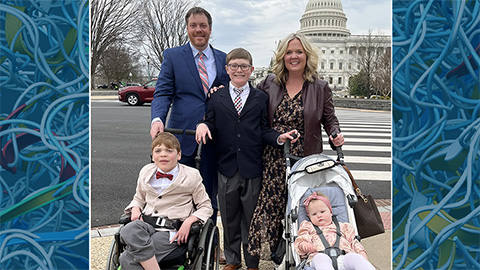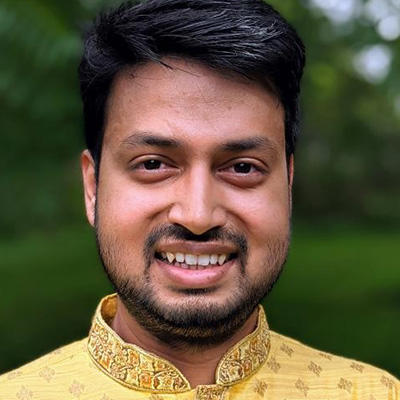The impact of nested identities
Throughout my academic research career, I have found myself in the role of mentee or mentor, often both at the same time. Navigating these roles as a person with multiple intersecting identities is both rewarding and challenging.
As a participant in the Leadership Engagement and Appreciation of Differences, or LEAD, reverse mentoring program, I mentored Allison McKenzie, a tenured professor and lab director at Chapman University in Irvine, Calif.; a project scientist at the University of California, Irvine; and a physical therapist. At the time, I was a Ph.D. candidate at Cornell University.

Intersectionality occurs when the interplay of multiple social and political identities dictates a unique set of challenges, inequalities and privileges for an individual. It became apparent in our conversations that the concept of intersection may not provide a full picture of the relationships among multiple identities.
While my South Asian identity dominates my appearance, I am also a member of the Dalit minority within the South Asian community. And my queer identity makes me a minority within a minority. What I call a “nesting doll” concept describes how some identities may be more apparent than others. Navigating nested identities can be even harder in an environment where some identities are less visible due to a lack of awareness, as in the case of international researchers.
My identity as a member of the historically marginalized Dalit community may not be obvious or considered relevant in the U.S. Many people here think casteism only prevails in South Asia. I explained to Allison that the repercussions of caste-based marginalization continue when people move to the U.S. from South Asian countries. A 2018 report, published by Equality Labs, a U.S.-based South Asian Dalit civil rights organization, and covered by the mainstream media, described incidents of caste-based discrimination in the workplace and education in the U.S.
I told Allison that my peers, in both India and the U.S., have questioned the merit of Dalit students who benefit from affirmative action in India. Hearing this prevents me from freely expressing my Dalit identity. The absence of role models around me, due to the lack of Dalit representation among my peers and faculty, compounds the problem. Talking about this helped us realize how marginalization can easily spill across borders.
To reduce the burden of performing my identities and to streamline our meetings, I created a document summarizing our conversations. I made lists of my identities and academic roles to guide our discussion of how each of my identities influenced my progress at different milestones in my career. We talked about how navigating my high school and undergraduate studies as a closeted queer student in India was very different than my graduate studies in the U.S. as an out queer person.
Having open discussions about my identities helped me realize the effort I have made over the years in navigating difficult circumstances. Allison told me about navigating her career as a woman in academia, and this encouraged me to share my experiences without the fear of being judged.
The LEAD program helped me realize that in mentoring we learn from the experiences of both the mentor and the mentee. Both can embrace perspectives informed by each other’s identities and backgrounds and work toward improving learning and productivity.
In practice, the power imbalance in mentor–mentee relationships may hamper the free exchange of ideas. And while our goals may be clear, often the path to achieving them is not, mainly because each mentor or mentee comes with a different learning background and identities.
The reversal of mentoring roles allows the power balance to shift to a diversified approach toward problem solving. Most importantly, reverse mentoring could inspire institutional measures that allow the mentors who are decision-makers to step into the shoes of mentees and understand the vast implications that our identities and backgrounds have on learning.
When mentor and mentee switch roles
The Federation of American Societies for Experimental Biology in 2022 introduced its Leadership Engagement and Appreciation of Differences, or LEAD, reverse mentoring program pairing senior-level professionals with junior-level mentors “to gain different perspectives of individual, group, and cultural views within the workplace and scientific research communities,” according to a FASEB announcement.
Among the 2023 LEAD participants were two members of the American Society for Biochemistry and Molecular Biology. Tina Tootle, a professor of anatomy and cell biology at the University of Iowa, was a mentee. Saket Bagde, then a Ph.D. candidate at Cornell University, was a mentor. Tootle and Bagde were not paired with each other in the mentoring program.
We invited each of them to write about their experience. Read Tina Tootle’s essay.
FASEB will start accepting applications for the 2024 LEAD program in late spring. Check here for details.
Enjoy reading ASBMB Today?
Become a member to receive the print edition four times a year and the digital edition monthly.
Learn moreGet the latest from ASBMB Today
Enter your email address, and we’ll send you a weekly email with recent articles, interviews and more.
Latest in Opinions
Opinions highlights or most popular articles

Debugging my code and teaching with ChatGPT
AI tools like ChatGPT have changed the way an assistant professor teaches and does research. But, he asserts that real growth still comes from struggle, and educators must help students use AI wisely — as scaffolds, not shortcuts.

AI in the lab: The power of smarter questions
An assistant professor discusses AI's evolution from a buzzword to a trusted research partner. It helps streamline reviews, troubleshoot code, save time and spark ideas, but its success relies on combining AI with expertise and critical thinking.

How AlphaFold transformed my classroom into a research lab
A high school science teacher reflects on how AI-integrated technologies help her students ponder realistic research questions with hands-on learning.

Writing with AI turns chaos into clarity
Associate professor shares how generative AI, used as a creative whiteboard, helps scientists refine ideas, structure complexity and sharpen clarity — transforming the messy process of discovery into compelling science writing.

Teaching AI to listen
A computational medicine graduate student reflects on building natural language processing tools that extract meaning from messy clinical notes — transforming how we identify genetic risk while redefining what it means to listen in science.

What’s in a diagnosis?
When Jessica Foglio’s son Ben was first diagnosed with cerebral palsy, the label didn’t feel right. Whole exome sequencing revealed a rare disorder called Salla disease. Now Jessica is building community and driving research for answers.

